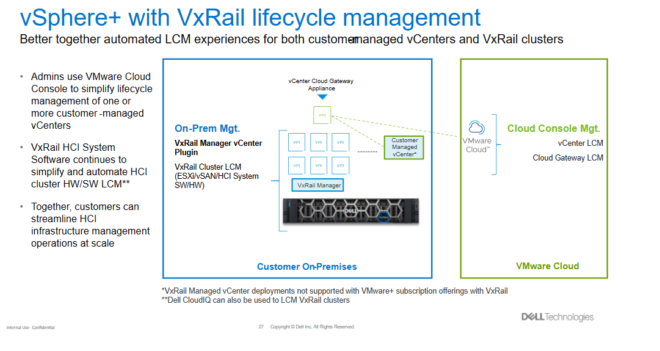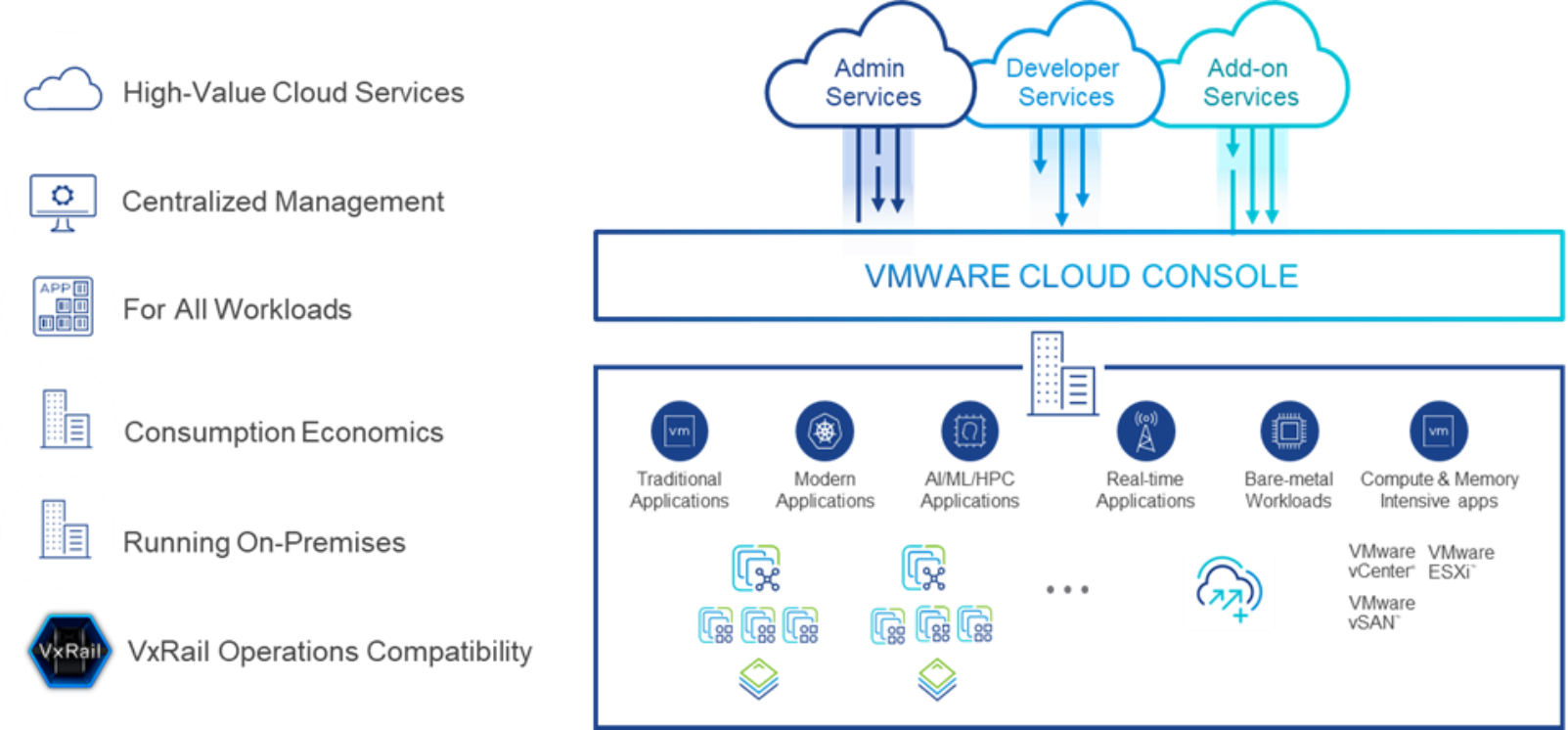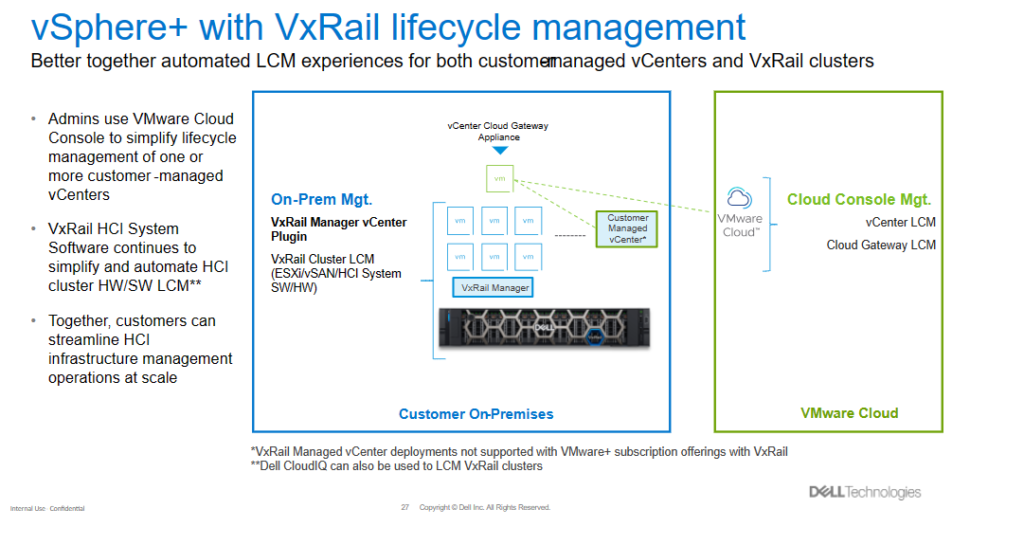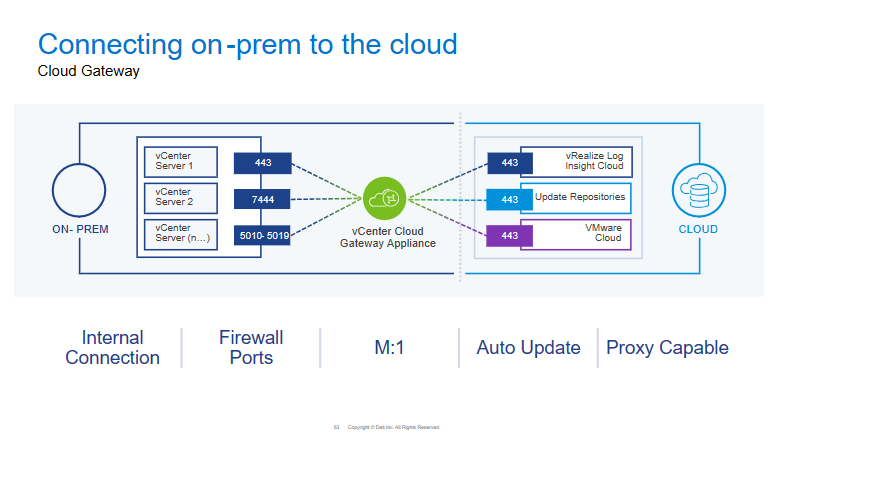
VMware has introduced new subscription offerings for vSphere, vSAN, and VMware Cloud Foundation. These subscription offerings fall into two types: cloud connected metered subscriptions and on-premises term subscriptions.
The cloud connected metered subscriptions are referred to as vSphere+, vSAN+, and Cloud Foundation+ respectively. For vSphere+ and vSAN+, they can be purchased by product (though vSphere+ is a prerequisite for purchasing vSAN+) or through VMware Cloud Edition offerings in which multiple products are packaged in a single bundle SKU. VMware Cloud Foundation+ is only available in VMware Cloud Edition bundles. All of these are multicloud workload platform subscription offerings that bring the benefits of cloud connected VMware Cloud services to customers’ on-premises workloads.
The on-premises cloud disconnected subscription offers are referred to as vSphere-S, vSAN-S, and Cloud Foundation-S. Similar to the cloud connected versions, the vSphere-S and vSAN-S offerings can be purchased by product or through VMware Cloud Edition offerings. VMware Cloud Foundation-S is only available in VMware Cloud Edition bundles.
VMware introduced these cloud disconnected subscription offerings to meet the needs of organizations who cannot connect or do not desire to connect their on-premises infrastructure to the cloud but still want to consume infrastructure using an OPEX subscription model. Because VxRail is an HCI-integrated system jointly engineered with VMware, it should come as no surprise that these new subscription options are supported with VxRail. This section provides details about the VxRail deployment architecture considerations that are required when using vSphere+ and vSAN+ (or Cloud Edition bundles) with VxRail. It also discusses the relevant vSphere+ component architecture and networking requirements associated with deploying the vCenter Cloud Gateway Appliance that is used to connect to VMware Cloud Services and, in particular, the VMware Cloud Console for metering and hybrid cloud services features. Finally, this section provides an overview of day 2 operational considerations related to lifecycle management and how, with VxRail, the vSphere+ lifecycle service complements the on-premises cluster LCM experience delivered through VxRail HCI System Software.
vSphere+ and vSAN+ with VxRail deployment considerations
vSphere+ and vSAN+ cloud-connected offerings with VxRail deliver the benefits of the cloud to on-premises workloads. These offerings bring benefits across three areas:
- They supercharge IT productivity with new admin services that are available through a centralized SaaS-based VMware Cloud Console.
- They accelerate innovation with developer services by transforming existing virtual infrastructure into an enterprise ready Kubernetes platform by including VMware Tanzu related components and services as part of the offering out-of-the-box rather than as an add-on that needs to be separately tracked and transacted.
- They help transform on-premises infrastructure by connecting it to VMware Cloud services. Customers can quickly extend their on-premises infrastructure to take advantage of additional VMware cloud services without disruption. An example of this is leveraging VMware Cloud Disaster Recovery services to replicate on-premises workloads to the VMware Cloud.

Figure 15. VMware Cloud Services with vSphere+ and vSAN+
This figure depicts the high-level architecture available with the VMware vSphere+ and vSAN+ offerings with VxRail. Highly valued VMware Cloud Services, such as Admin Services, Developer Services, and Add-on Services will continue to be developed, enhanced, and made available over time to customers to extend the capabilities of their on-premises VxRail environment.
Centralized management for these services is provided through the VMware Cloud Console. The on-premises infrastructure that hosts all customer workloads connects to the VMware Cloud Console through deployed virtual Cloud Gateway appliances. The appliances communicate with customer managed, on-premises vCenter Servers and transmit the metered infrastructure usage to the VMware Cloud, enabling a pay-for-what-you-use level of consumption economics. For VxRail environments, all this is delivered with VxRail operations compatibility in mind. VMware Cloud Services and VMware Cloud Console interactions are complementary to the value-added on-premises infrastructure management environment that VxRail offers through Dell CloudIQ, the VxRail HCI System Software, and its integrations with VMware Cloud Foundation SDDC Manager.
VMware Cloud Console does not replace existing on-premises VxRail infrastructure operations tools when using vSphere+ and vSAN+ with VxRail. In fact, using them together delivers a complementary and automated lifecycle management experience for customer-managed vCenters and VxRail clusters, simplifying the operations for cluster management for customers.
The following figure depicts this lifecycle management experience. Copyright © Dell Inc. All Rights

Figure 16. Lifecycle management experience for VxRail cluster and VMware Cloud Console
vCenter Cloud Gateway deployment considerations
There are multiple prerequisites for the vCenter Cloud Gateway appliance to work properly:
- Internet connection—Although vCenter Servers are not connected to the Internet, the Cloud Gateway appliance requires Internet access to be able to communicate with VMware Cloud.
- Firewall ports—Certain ports should be open (port 443, in particular) for proper communications to and from the Cloud Gateway appliance.
- Resources—There should be enough resources (memory, CPU, storage) in the cluster where the Cloud Gateway appliance will be deployed.
The following figure illustrates these networking considerations for deploying the vCenter Cloud Gateway Appliance.

Figure 17. Network considerations when deploying vCenter Cloud Gateway Appliance
vSphere+ and vSAN+ with VxRail help customers deliver the benefits of the cloud to on-premises workloads. IT teams can begin supercharging productivity with admin services designed to enhance operational efficiency and centralize management with the VMware Cloud Console. It also simplifies VxRail customer-managed vCenter lifecycle management through cloud-enabled automation, which is complementary to the existing automated VxRail cluster LCM capabilities delivered through the VxRail HCI System Software. It also helps by enabling customers to easily monitor global inventory, alert status, and even enable customers to provision VMs to any subscribed VxRail cluster from a centralized SaaS-based portal. It helps customers accelerate innovation with integrated developer services, which enable customers to take advantage of integrated VMware Tanzu component services and features that are included in available vSphere+ offerings, enabling customers to manage, operate, and run VM and container workloads on a common on-premises modern HCI infrastructure. Finally, it enables customers to transform their on-premises infrastructure with cloud integration by allowing them to extend on-premises workloads with add-on hybrid cloud services when needed and gain the flexibility of OPEX-based consumption while improving ROI from existing investments.
For more information about VMware software, see Additional resources.